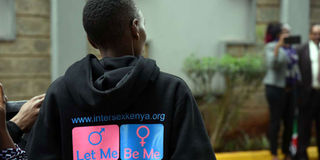Intersex society says they are more than census reported

Debate is raging on the actual number of intersex persons in the country. This follows the recent release of census report that indicate their numbers as very low.
The 2019 census results shows Kenya has 1,524 intersex persons.
An intersex person is one who by birth, does not fit the typical definitions for male or female bodies. Surgeries can sometimes be done to give one the desired gender.
The data, which was released by the Kenya National Bureau of Statistics (KNBS) also indicates a total of 47,564,296 persons were enumerated in August 2019 census, comprising 23,548,056 males and 24,014,716 females.
The report indicates Nairobi has the highest number of intersex persons in the 47 counties with 245, followed by Kiambu (135) and Nakuru (95).
However, Intersex Society of Kenya insist the number could be much higher.
HIDING TRUTH
Nominated Senator Mr Isaac Mwaura who is the society founder and patron, said it would be hard to know the exact number of intersex persons using the census since many people with that condition shy away from revealing their status. He was speaking at the society's headquarters in Ngara, Nairobi, last Friday.
He said lack of a provision for self-declaration during the census exercise could have made many intersex persons hide the truth.
“Enumerators could not authenticate whether what they were told is true or false since they cannot go ahead to check. Self-declaration is the only way that can ensure people with such conditions come out,” he said.
Mwaura, however, said it is a good start since the country now has a comprehensive data on inter-sex person contrary to many countries in the world including the developed ones.
Stigma associated with being intersex has kept many people from stepping out to be counted.
The senator added he has sponsored a Bill in Parliament, which is at second reading to amend the Registration of Persons Act to recognise intersex as a sex marker.
He also added the society will be pushing for the intersex persons to enjoy at subsidised cost of health, education and other vital government services.
The 2019 census marked a win as it was the first in the country’s history where intersex people were counted.
SCHOOL DROP OUT
The numbers by the census report on intersex persons comes to contradict Intersex Taskforce Report, 2018 which put an estimate of intersex persons at 779,414 based on Kenya’s population of 45.9 million (KNBS Statistical Abstract, 2017).
The taskforce used the upper limit of 1.7 per cent of the population as per the UN guideline, which approximates the population of intersex persons at 0.05-1.7 per cent of global births.
The report indicates majority of intersex persons are in the youth category (ages 18-35) are at 77 per cent.
It also showed 90 per cent of the adult intersex persons interviewed were either in secondary (36 per cent), primary (23 per cent) or had never completed any level of formal education (31per cent).
Only ten per cent according to the report of the adult intersex sampled had attained college or university education.
“Many intersex people may drop out of school much earlier due to negative peer pressure and societal stereotyping, when they find no place to belong as they can neither fit in the boys’ or girls’ schools, and there are no dedicated intersex educational facilities in Kenya,” the report says.
PARLIAMENT
The report also says parents became aware of the intersex status of their children at birth and/or during the early days of childhood; 23 per cent discovered it at puberty/teenage, while six per cent realized it in adulthood.
About 63 per cent of the intersex persons sampled self-identified themselves as male and actively cultivated a male gender, while 20 per cent recognised themselves as female with five per cent recognizing themselves as intersex.
A further 12 per cent according to the report were not ready to self-recognise as male/female/ intersex.
The 2018 report recommended that parliament, in consultation with stakeholders, facilitate recognition of intersex persons in the law.
This could be realised through the introduction of an Intersex (I) marker in all official documents that require identification of sex. This will involve amendment and introduction of a comprehensive definition of who an intersex person is:
The Ministry of Health in consultation with relevant agencies to formulate specialised programmes to provide for intersex persons’ care and protection in health facilities to facilitate their access to the highest attainable standard of health.




